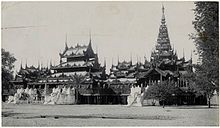| Shweinbin Monastery | |
|---|---|
ရွှေအင်ပင်ကျောင်း | |
 Shweinbin Monastery around 1900. | |
| Religion | |
| Affiliation | Theravada Buddhism |
| Location | |
| Country | Mandalay, Mandalay Region, Burma |
| Geographic coordinates | 21°57′59″N 96°03′57″E / 21.966280°N 96.065954°E |
| Architecture | |
| Completed | 1895 |
Shweinbin Monastery (Burmese: ရွှေအင်ပင်ကျောင်း) is a Buddhist monastery in Mandalay, Burma, built in the tradition of Burmese teak architecture.[1] The monastery was built in 1895 by a Sino-Burmese merchant married to a Burmese woman of royal extraction. The monastery's construction strictly adheres to traditional rules of Burmese monastic architecture and includes all of the designated pyatthat-crowned pavilions.[2][3][4]
See also
[edit]References
[edit]- ^ Wilson, Constance. "Part II - Mandalay, The Burmese Heartland". Northern Illinois University. Retrieved 13 July 2015.
- ^ Ma Thanegi. "Religious architecture" (PDF). Retrieved 13 July 2015.
- ^ Ma Thanegi (2005). Myanmar Architecture: Cities of Gold. Marshall Cavendish. p. 100. ISBN 9789812329165.
- ^ "15-17 November 1995". Proceedings of the Conference on Myanmar and Southeast Asian Studies. Yangon: Universities Historical Research Centre: 309. 1996.

Well, that’s interesting to know that Psilotum nudum are known as whisk ferns. Psilotum nudum is the commoner species of the two. While the P. flaccidum is a rare species and is found in the tropical islands. Both the species are usually epiphytic in habit and grow upon tree ferns. These species may also be terrestrial and grow in humus or in the crevices of the rocks.
View the detailed Guide of Psilotum nudum: Detailed Study Of Psilotum Nudum (Whisk Fern), Classification, Anatomy, Reproduction